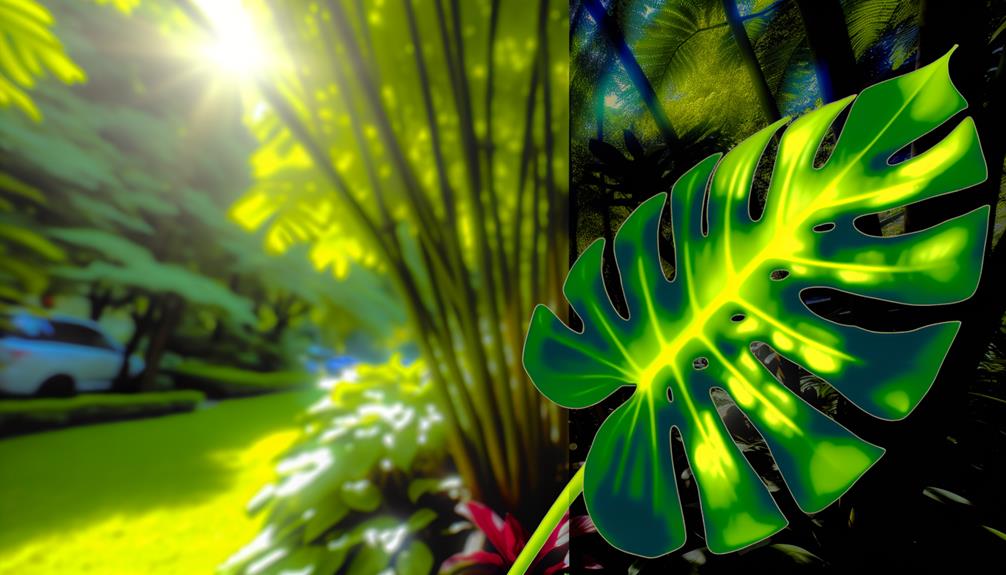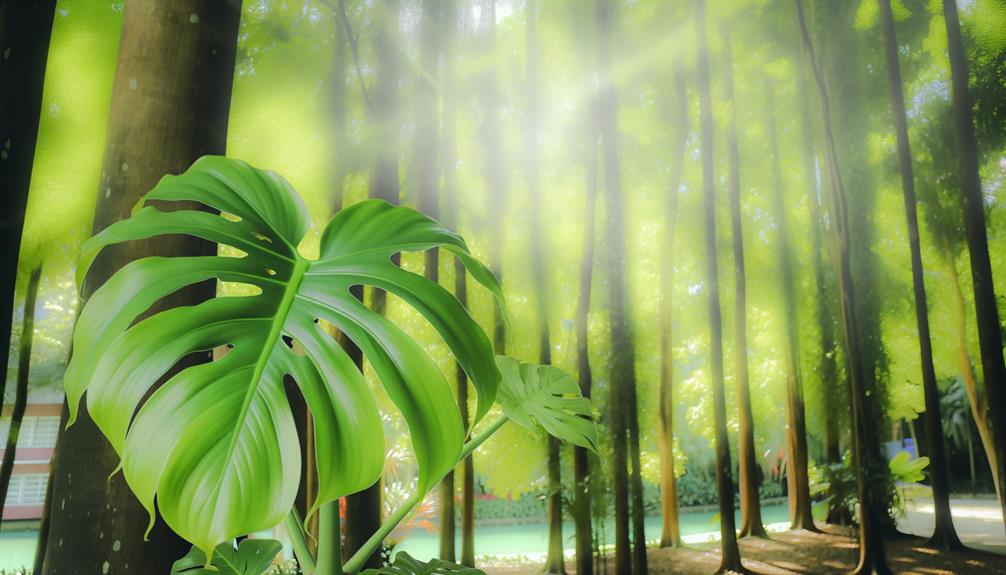Can Monstera Deliciosa Tolerate Full Sun Outdoors? Explained
Monstera Deliciosa is not well-suited to full sun exposure outdoors. Prolonged exposure to direct sunlight can cause leaf scorching and reduced photosynthetic efficiency, leading to stunted growth and dehydration.
For best growth, Monstera requires bright, filtered light and thrives in conditions where light levels range between 1000 to 2500 lux. Proper placement in indirect sunlight combined with well-draining soil, consistent moisture, and 60-80% humidity are crucial.
Protective measures such as shade cloths and natural barriers are recommended. Regular monitoring for stress indicators and timely intervention is essential for maintaining plant health.
For more in-depth analysis, continue your exploration.

Key Takeaways
- Monstera Deliciosa cannot tolerate full sun; it causes leaf scorching and dehydration.
- Exposure to full sun significantly reduces Monstera Deliciosa’s photosynthetic efficiency and stunts growth.
- Optimal growth occurs under indirect, filtered light, avoiding direct sunlight.
- Using shade cloths or natural barriers can protect Monstera Deliciosa from full sun.
- Regular monitoring and timely intervention help prevent stress from excessive sunlight.
Understanding Monstera Deliciosa’s Light Needs

Monstera deliciosa, a popular tropical plant, thrives best under indirect light conditions, yet it exhibits a remarkable adaptability to varying light environments.
Research indicates that Monstera deliciosa can tolerate low to moderate light levels, making it suitable for indoor cultivation. Optimal growth is achieved in bright, filtered light, which mimics its native understory rainforest habitat.
Excessive shade may impede its photosynthetic efficiency, resulting in slower growth and smaller leaves. Conversely, exposure to intense, direct sunlight can cause photoinhibition, leading to chlorosis and leaf burn.
Studies suggest that maintaining light levels between 1000 to 2500 lux is ideal for this species. Understanding these parameters is essential for maximizing its aesthetic and physiological health, ensuring robust development and vibrant foliage.
Effects of Full Sun on Monstera
While thriving in bright, filtered light is best, examining the effects of full sun exposure on Monstera deliciosa reveals significant physiological and morphological changes.
Direct sunlight can lead to:
- Leaf Scorching: Prolonged exposure results in leaf burn, characterized by brown, crispy edges due to excessive radiation absorption.
- Reduced Photosynthetic Efficiency: Overexposure to intense light can impair the plant’s chlorophyll, leading to chlorosis and diminished photosynthetic performance.
- Stunted Growth: High light intensity can stress the plant, causing reduced leaf size and overall stunted development.
- Dehydration: Increased transpiration rates in full sun conditions can lead to rapid water loss, exacerbating drought stress and affecting turgor pressure.
Understanding these responses is essential for ideal Monstera deliciosa cultivation, ensuring plant health and vigor.
Ideal Outdoor Conditions

Enhancing outdoor conditions for Monstera deliciosa involves guaranteeing sufficient shade, preserving consistent soil moisture, and safeguarding the plant from extreme weather fluctuations. The species flourishes in environments that replicate its native tropical habitat, requiring indirect light, well-draining soil, and humid conditions.
Research indicates that Monstera deliciosa’s root system needs aeration to prevent root rot, a common issue in excessively wet soils. Additionally, temperature stability within the range of 65-85°F is crucial for optimal growth.
| Factor | Ideal Condition |
|---|---|
| Light | Indirect sunlight |
| Soil | Well-draining, aerated |
| Moisture | Consistent, not soggy |
| Humidity | 60-80% |
| Temperature | 65-85°F |
Attention to these parameters guarantees robust growth and minimizes stress, enhancing the plant’s overall well-being.
Tips for Sun Protection
Effectively shielding Monstera deliciosa from direct sunlight involves using shade cloths and strategically positioning the plant to receive filtered light, thereby mitigating the risk of leaf scorch and photodamage. Empirical evidence suggests that implementing sun protection techniques can greatly enhance the plant’s resilience in outdoor environments.
Consider the following strategies:
- Shade Cloths: Employ 30-50% shade cloths to filter harsh sunlight and reduce UV radiation exposure.
- Natural Barriers: Plant Monstera deliciosa near taller plants or structures to create natural shade, reducing direct sun impact.
- Seasonal Adjustment: Adjust the plant’s position seasonally to account for changes in sun intensity and angle.
- Reflective Mulch: Utilize reflective mulch to diffuse sunlight and protect the root zone from overheating.
These methods collectively provide a robust framework for maintaining ideal sun protection.
Monitoring Plant Health

Regular monitoring of Monstera deliciosa’s health is crucial, as it enables early detection of stress indicators such as chlorosis, leaf burn, and pest infestations, thereby facilitating timely intervention and promoting ideal plant vigor.
Chlorosis, characterized by yellowing leaves, often indicates nutrient deficiencies or improper watering. Leaf burn, identifiable by brown, crispy edges, suggests excessive sun exposure or insufficient humidity. Pest infestations, including spider mites and scale insects, can manifest as discolored spots or a sticky residue on leaves.
Employing a systematic approach, such as weekly inspections, coupled with meticulous record-keeping, allows for precise identification of abnormalities and correlation to environmental changes. Implementing corrective measures, such as adjusting light exposure or applying appropriate treatments, ensures sustained plant health and robustness.
Swiss Cheese Plant Monstera Deliciosa Grow Outside
Monstera deliciosa, also known as the Swiss Cheese Plant, can be grown outside, but it is important to consider the plant’s native environment and specific needs. Outdoors, Monstera deliciosa prefers a shaded to semi-shaded position protected from hot midday sun, as the leaves can easily burn in direct sunlight, especially if the plant was previously grown indoors. Acclimating the plant gradually to outdoor light is crucial.
As a native to tropical rainforests, Monstera may struggle with extreme temperature changes or harsh weather conditions outdoors. In the UK, it can be grown outside for about 8 months but may need protection from freezing temperatures in winter.
When planted in the ground, Monstera thrives in free-draining soil that is rich in organic matter, and amending the soil with compost can help improve drainage and nutrients.
Monstera prefers to dry out slightly between waterings, so allow the top 5cm of soil to dry before watering again and reduce watering in winter. Outdoor plants are more susceptible to pests and diseases compared to indoor ones, so regularly inspect the plant and take action if needed.
To avoid shock, gradually introduce an indoor Monstera to outdoor conditions over several weeks. It may take a year or more for the plant to fully adapt to direct sun. While Monstera can be grown outdoors, especially in tropical or subtropical climates, an indoor plant will require a careful transition. Providing the right light, soil, water, and protection will help a Swiss Cheese Plant thrive outside.
Conclusion
To sum up, Monstera deliciosa, while adaptable, can suffer under the relentless glare of full sun, akin to a delicate flower scorched by fire.
Scientific evidence indicates that partial shade and controlled light exposure foster best growth and health.
Implementing sun protection measures and closely monitoring for stress indicators are prudent strategies.
Therefore, careful management of light conditions is paramount to ensuring the robust development and longevity of Monstera deliciosa in outdoor environments.






